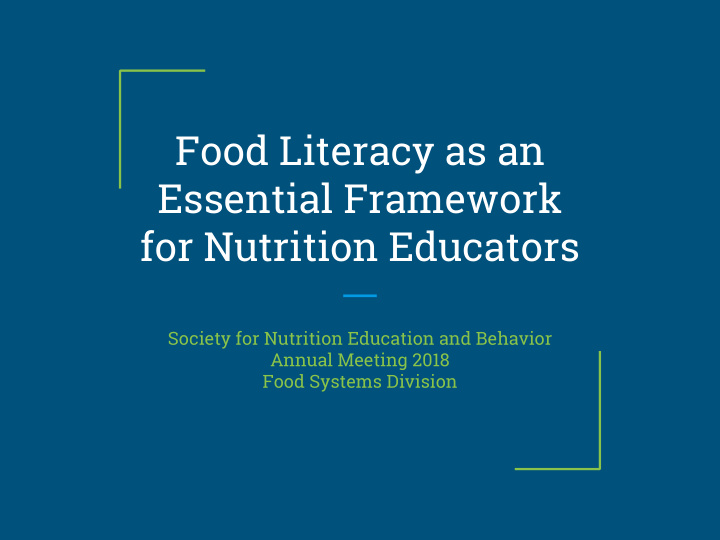



Food Literacy as an Essential Framework for Nutrition Educators Society for Nutrition Education and Behavior Annual Meeting 2018 Food Systems Division
Introductions Session Moderator: Pamela Koch, EdD, RD; Teachers College, Columbia University Panelists: Sarah Amin, PhD, MPH, University of ● Rhode Island Anupama Joshi, MS, National Farm to ● School Network Megan Lehnerd, PhD, Framingham State ● University Eva Ringstrom, MPA/MUP, FoodCorps ●
Overview: Food literacy & nutrition education
Overview: Food literacy & nutrition education Food literacy is the scaffolding that empowers individuals, households, communities, and nations to protect diet quality through change and strengthen dietary resilience over time. It is composed of a collection of interrelated knowledge, skills, and behaviors required to plan, manage, select, prepare, and eat food to meet needs and determine intake.” -Vidgen, 2014
Child Food Literacy
Child Food Literacy: Formative Research Gardening: Weeding § “So actually, clipping it doesn’t always work even if you clip right at the base. Know why? Because it just grows back” Cooking § “Every Friday and mostly every night I cook with my mom because I want to be a cook when I grow up and I want to try out for Master Chef Junior” Food Processing § “They pull the potato, they wash it, they julienne it, and then they put oil on it and fry it” Food Groups § “It’s a MyPlate thing…there’s five of them and you need all of them to make up one big super healthy meal”.
Tool for Food Literacy Assessment in Children (TFLAC) 25 questions, 40 points ● ● 4th & 5th graders
Gardening
Farm visits
School Meals
Chefs in the Classroom
Taste Tests
Cooking Competitions
Cooking
Corn Shucking Contest
Having fun with food!
FoodCorps members serve in high-need schools, using a three- ingredient recipe for healthy school food environments, to increase healthy food consumption and build habits that last a lifetime. HANDS-ON HEALTHY SCHOOLWIDE LEARNING SCHOOL MEALS CULTURE OF HEALTH ✦ Ongoing cooking, tasting, & ✦ Salad bar & lunch line design ✦ Celebrations, events, rewards & garden-based lessons snacks ✦ Taste tests ✦ Field trips and farmer & chef ✦ Family, staff & community ✦ Cafeteria role modeling visits education ✦ Local sourcing & recipe ✦ School garden development & ✦ Making curriculum development maintenance connections ✦ Schoolwide healthy food ✦ Healthy school food champion promotion & team support ✦ School community support
FoodCorps Lessons Framework: Six Themes 1. Living up to our full potential 2. Making healthy food choices 3. Exploring the ecology of food 4. Connecting to food, culture and community 5. Growing and accessing healthy food 6. Preparing healthy food
List of Food Literacy Resources (page 1 of 2) Contact Megan Lehnerd for a copy of this list - mlehnerd@framingham.edu Amin, S. A., Panzarella, C., Lehnerd, M., Cash, S. B., Economos, C. D., & Sacheck, J. M. (2018). Identifying Food Literacy Educational Opportunities for Youth. Health Education & Behavior. Amin, S. A., M.E. Lehnerd, S.B. Cash, C.D. Economos and J.M. Sacheck. (Under review) The validity and reliability of a youth food literacy survey. Journal of Nutrition Education and Behavior. Brooks, N., & Begley, A. (2014). Adolescent food literacy programmes: A review of the literature. Nutrition & Dietetics, 71(3), 158-171. Doustmohammadian, A., Omidvar, N., Keshavarz-Mohammadi, N., Abdollahi, M., Amini, M., & Eini-Zinab, H. (2017). Developing and validating a scale to measure Food and Nutrition Literacy (FNLIT) in elementary school children in Iran. PloS one, 12(6), e0179196. Krause, C., Sommerhalder, K., Beer-Borst, S., & Abel, T. (2016). Just a subtle difference? Findings from a systematic review on definitions of nutrition literacy and food literacy. Health promotion international, 33(3), 378-389. Krummel D., Urbina F., Buchanan B., Warner D., & Lee, S. (2017). Self-Efficacy Related to Food Literacy Increases Following a Pilot Intervention in Low-Income Mothers. Journal of the Academy of Nutrition and Dietetics, 117(9). Liao, L. L., Lai, I. J., Chang, L. C., & Lee, C. K. (2016). Effects of a food advertising literacy intervention on Taiwanese children’s food purchasing behaviors. Health education research, 31(4), 509-520.
List of Food Literacy Resources (page 2 of 2) Perry, E. A., Thomas, H., Samra, H. R., Edmonstone, S., Davidson, L., Faulkner, A., ... & Kirkpatrick, S. I. (2017). Identifying attributes of food literacy: A scoping review. Public health nutrition, 20(13), 2406-2415. Poelman, M. P., Dijkstra, S. C., Sponselee, H., Kamphuis, C. B., Battjes-Fries, M. C., Gillebaart, M., & Seidell, J. C. (2018). Towards the measurement of food literacy with respect to healthy eating: the development and validation of the self perceived food literacy scale among an adult sample in the Netherlands. International Journal of Behavioral Nutrition and Physical Activity, 15(1), 54. Thomas, H. M., & Irwin, J. D. (2011). Cook It Up! A community-based cooking program for at-risk youth: overview of a food literacy intervention. BMC research notes, 4(1), 495. Truman, E., Lane, D., & Elliott, C. (2017). Defining food literacy: A scoping review. Appetite, 116, 365-371. Vidgen, H. A., & Gallegos, D. (2014). Defining food literacy and its components. Appetite, 76, 50-59. Vidgen, H. (2016). Relating food literacy to nutrition and health. In Food Literacy (pp. 82-100). Routledge. Whiteley, C., & Matwiejczyk, L. (2015). Preschool program improves young children’s food literacy and attitudes to vegetables. Journal of nutrition education and behavior, 47(4), 397-398. Thanks to Dr. Isobel Contento, Kristen Corinaldesi, and Julie O’Shea at Teachers College for their assistance compiling many of these resources!
Recommend
More recommend